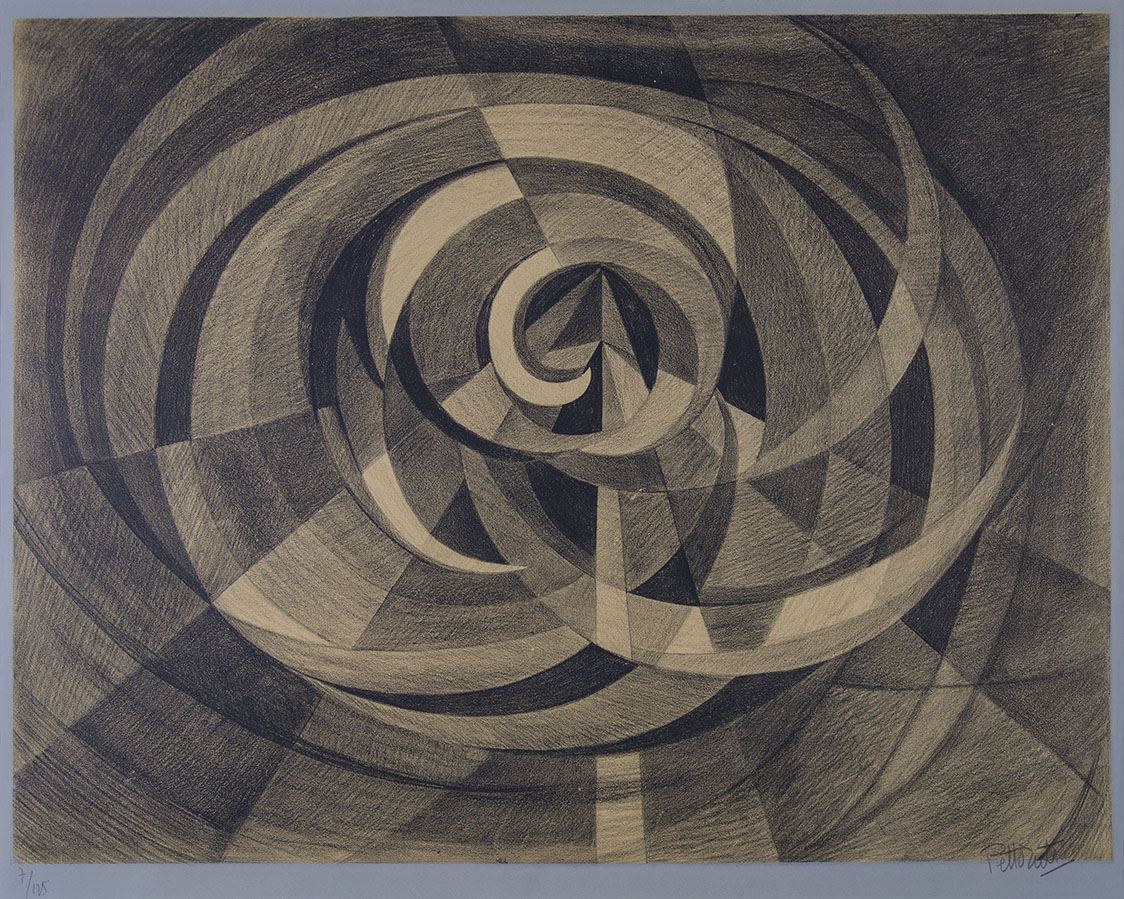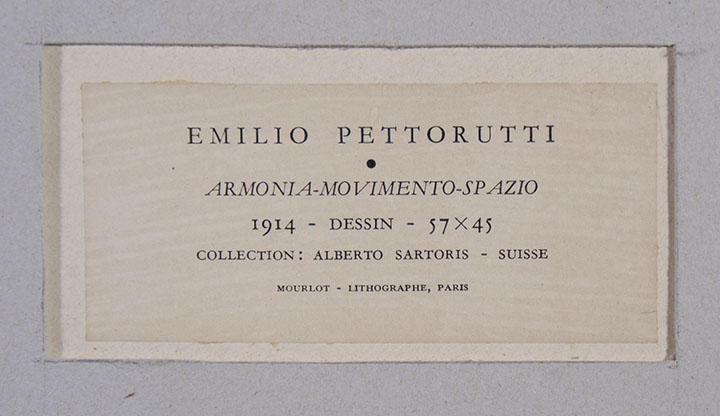Armonia - Movimento - Spazio. Mourlot. Lithographe. (Paris. 1965)
Lithograph on paper, numbered (7/125) and signed in graphite pencil. On the reverse, the original label, with the name of the author misspelled, "PETTORUTTI", the title of the work, year of execution, measurements, lithographer and the indication: "COLLECTION: ALBERTO SARTORIS - SUISSE". Measurements: 45 x 57 cm / 17.71 x 22.44 in. Framed work. It was made in Paris from Pettoruti's original drawing, by the prestigious engraver Fernand Mourlot.
Pettoruti executed that graphite a year after his arrival in Europe, where the first avant-gardes of the beginning of the century were bubbling: the collage of Picasso and Braque, Futurism, the works of Alfred Jarry, the poetry of Apollinaire and the abstract art of Vasily Kandinsky, Robert Delaunay and Piet Mondrian gave new life to modern art. Pettoruti quickly absorbed the nascent Futurist movement in Italy. “We affirm that the magnificence of the world has been enriched by a new beauty: the beauty of speed. A racing car, with its radiator adorned with thick tubes like snakes of explosive breath ... a roaring car, which seems to run on shrapnel, is more beautiful than the Victory of Samothrace” wrote Marinetti in his Manifesto, in February of 1909. Armonia-movimento-spazio agrees in a way with these new concepts, contrary to the contemplative statism of impressionism, or reflective of symbolism, and refers to the spatial dimension and the harmony of the spheres. Radial dynamism, irradiation of a star, is added to the spiral, relative to the movement of a celestial body. But Pettoruti goes even further, arriving at pure geometric abstraction.
This absolutely revolutionary and advanced work inaugurates abstract art in the country. Pettoruti returned to our country in 1924 and the exhibition of his futuristic works in the Witcomb Hall caused a stir. It will take many years, until the 1940s, for concrete art to be formalized in Argentina as a movement.
The original work is a graphite, which his friend the futurist architect Alberto Sartoris bought. (1) It's called Armonia. Movement spazio. Disegno astratto (1914, Col. A. Sartoris, Lutry, Switzerland, CR N ° 21), today in the MALBA collection. “Both Armonia-movimento-spazio (disegno astratto) and Forze centripete belonged to the collection of Alberto Sartoris (1901–1998), a natural situation if we consider that the architect and theorist of architecture, in addition to being a historian and art critic, had busy with Pettoruti's work, since the late 1930s, repeatedly. The choice of those drawings to enter his collection was not accidental either: Armonia-movimento-spazio (disegno astratto) had been exhibited for the first time in 1914 in Florence, at the Prima Esposizione Invernale Toscana”, writes Patricia M. Artundo (2).
“As reported by Pettoruti in his memoirs, his friendship with Sartoris went back to his stay in Paris in 1922. From that moment on, both had a series of sporadic contacts, but marked by a strong aesthetic and ideological affinity, due among other reasons to the early and profound mark left on them by the first Futurism and also the search, determining in their work, for a principle of classical order and clarity reformulated in the terms of the constructive avant-gardes of the 1920s. In fact, Sartoris was one of the main promoters of Pettoruti's painting in Europe, a painting that illustrates several of his works dedicated to modern architecture and plasticity”. Alejandro Crispiani: SEE
The drawing Armonia, movimento spazio is key, since Pettoruti -painter who introduced Futurism and Cubism in our country- did it when he was working with the Futurist avant-garde, in Milan, in 1914. Experienced engravers made the prints under the artist's supervision: the lithograph was made from the 1914 drawing, in the printing house of the renowned engraver Fernand Mourlot, in Paris in 1965.
Emilio Pettoruti (La Plata, 1892 - 1971, Paris) was a pioneering painter in the national avant-garde. He began his career as a cartoonist in his hometown, and through a grant from the provincial government he traveled to Europe in 1913, where he resided for many years. In Florence he studied at the Royal Academy of Fine Arts and became linked to Futurism. Between 1916 and 1917 he lived in Rome, where he related to artists who proclaimed (after the First World War) a return to the classical. At that same time he struck up a deep friendship with Xul Solar. He then went on to cubism. In 1924 he traveled to Paris where he met Juan Gris in Paris, and returned to the country with Xul Solar. That same year he exhibited at the Witcomb Gallery, individually, shows that generated a scandal: detraction from the costumbristas and admiration on the part of the progressives. In 1930 he was offered the position of director of the Provincial Museum of Fine Arts of La Plata, a function he held for seventeen years. In 1952, due to differences with the Peronist government, he returned to Europe, dying in Paris in 1971.
Notes:
1. Alberto Sartoris (Turin, Piedmont, Italy, 1901 - Pompaples, Vaud, Switzerland, 1998) was a Swiss architect, designer, teacher and art critic of Italian origin.
2. Text by Patricia M. Artundo, originally published, in English version, in Modern and Contemporary Masterworks from Malba - Fundación Costantini (cat. Exp.), Mari Carmen Ramirez and Marcelo E. Pacheco (eds.), Museum of Fine Arts , Houston, 2012.
S.O.H-XI - HSL
| AUTHOR | EMILIO PETTORUTI |
|---|
Are you interested in selling some works?
Send us an email briefly indicating
which works you intend to put on sale, and we will respond. click here
Subscribe to our newsletter to be updated.
Check our Newsletters
